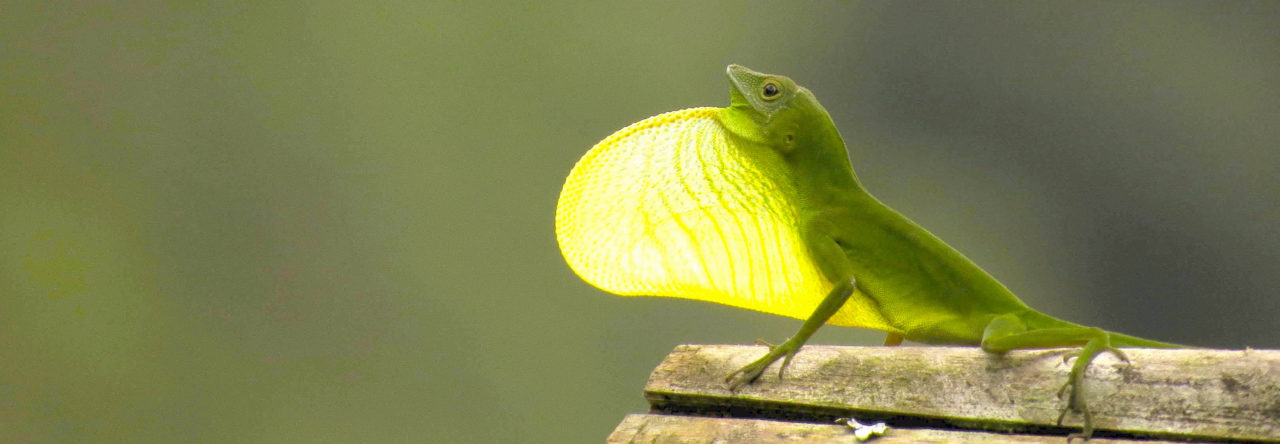
Martha Munoz starting the all-anole morning with a comparison of the thermal niches of different species of Hispaniolan cybotoid anoles
The symposium “The Biological Impacts of Tropical Climate Warming for Ectothermic Animals,” was recently (Aug. 1-3) held in San Juan Puerto, and it was a great success. In a two-part post, I will provide a brief summary. Today will focus on four talks on the second morning, all of which focused on Anolis. In the next post, I will review the rest of the symposium.
Martha Muñoz began the day by talking about the thermal biology of cybotoid anoles (members of the cybotes species group) in Hispaniola. These species show a remarkable elevational range from sea level to over 3000 meters. Martha pointed out that in this respect, Hispaniola is a much better place to look at questions related to elevation than Puerto Rico, a comment greeted with jeering from much of the crowd. Nonetheless, she scoffed at the discussion of the “high elevation” A. gundlachi at 850 m. Why, A. shrevei, in Hispaniola doesn’t even occur that low! In any case, what Martha showed is that despite the great thermal differences in habitats at different elevations, the cybotoids maintained approximately the same body temperature at all sites and have the same preferred temperatures and critical thermal maxima. Clearly, they are using thermoregulatory behavior to buffer their thermal physiology from selection in different environments and, indeed, field observations show that high elevation species do bask more. However, anoles can’t thermoregulate at night, and there is where adaptive differentiation occurs: high elevation anoles can withstand lower temperatures than lower elevation species. To clinch the deal, Martha measured the temperatures lizards experience at night. Indeed, the species at high elevation experience temperatures that would kill low elevation species.
Luisa Otera spoke next on the “Effects of recent climate warming on the reproductive phenology of Puerto Rican Anolis lizards.” Luisa revisited sites at which George Gorman had examined A. cristatellus 40 years ago. Gorman had found that at higher elevations, female reproduction tapered off in the winter, whereas at lower elevations, they continue reproducing year-round. Her prediction was that with higher temperatures, reproduction should be extended in the winter at high elevations. For the most part, this prediction was confirmed, though surprisingly not so at the sea-level site.
Most surprising, in a new twist, Luisa found that female reproduction could vary over a very short spatial scale. In particular, if a lizard has a territory in the open with a lot of sun, it can breed year round, whereas it’s neighbor under the shade of trees a few meters away may not be able to do so in the winter. Perhaps this explains the contrary finding at the sealevel sites: greater tree cover may have actually made conditions worse.

Luisa pointed out that warming isn’t always bad–for some lizards, it allows them to extend their breeding seasons

Gunderson’s data show that even lizards with body temperatures outside of their preferred range are still quite active
Alex Gunderson spoke next on “Behavioral responses to climate change: natural selection on the thermal physiology of Anolis sagrei.” Perceptive readers will note that these three talks focused sequentially on the trunk-ground anoles of three different islands. Coincidence? You be the judge. In any case, in a very thought-provoking talk, Alex pointed out that much of the literature predicting the response of species to global warming focuses on the effect that higher temperatures will have on the time in which lizards can be active, which affects factors like food acquisition. However, Gunderson note that although activity time is usually treated as a binary variable—a lizard is either active or it isn’t—his extremely detailed behavioral data (299 focal observations), indicate that, in fact, the effect of temperature on activity is continuous rather than binary. Indeed, lizards engage in all major activities—eating, mating, fighting—at temperatures substantially outside (mostly below) their “preferred temperatures.” This finding calls for a re-thinking of how we model the effects of climate change on lizard populations—they may be forced to be active at temperatures they’re not so happy about, but they will do more than stay in their hidey-holes.
Next, Michael Logan reprised his talk on the “Rapid evolution in response to climate change: natural selection on the thermal physiology of Anolis sagrei” which he gave at the Evolution meetings five weeks previously. But here he had twice as much time to speak and correspondingly gave greater details. Since I’ve reported on the talk previously, I’ll just summarize here: in a very cool experiment, he moved brown anoles from a shady habitat to a much hotter one. Before doing so, he measured the performance curves of each lizard (i.e., how their ability to sprint was affected by temperature). His prediction was that individuals that could sprint at higher temperatures would be favored by natural selection in the new habitat. And sure enough, they were! By contrast, another population in a shaded habitat experienced no selection on thermal performance. If thermal sensitivity of sprinting is a heritable trait—a big if, Mike noted—this strong selection could suggest that populations might be able to adapt very rapidly to warming climates.
- Evolution in Real Time on Lizard Island - March 23, 2025
- Spider Snags Adult Anolis osa - March 22, 2025
- An Homage to the Green Anoles of New Orleans - March 21, 2025



Ambika Kamath
Really cool to see the focus on, and fascinating results that emerge from, within-population variation among individuals.